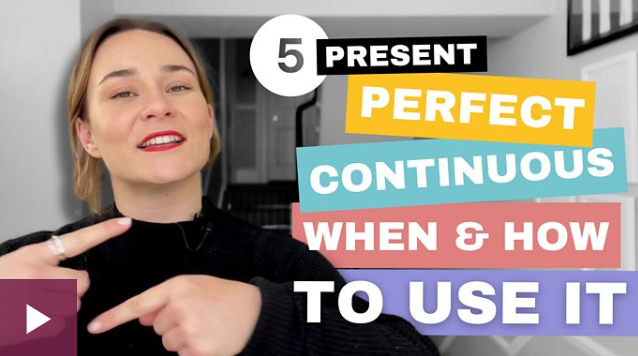Like the present perfect, the present perfect continuous is used to talk about the past, but there’s often a connection to the present. It focuses on the activity and the duration of the activity.
USES OF PRESENT PERFECT CONTINUOUS
Actions that started in the past and are continuing to the present.
- I’ve been working as a teacher since 2019. (I’m still working as a teacher)
- We’ve been playing tennis together for most of our lives. (We still play together)
- We’ve been saving money for our dream holiday. (We’re still saving)
- She‘s been learning French for a while now. (She’s still learning)
Useful vocabulary for actions that started in the past and are continuing to the present: for (durations) and since (from a point in time)
Recent continuous activities in the past that have a present result that you can see.
- I can see Dad’s been cleaning this morning. It’s so tidy. (He’s not cleaning now, but you can see that he has been)
- Wow, look outside! It’s been snowing. (It’s not snowing now, but you can see that it has been)
- Mmm, smells delicious. The kids have been baking. (They’re not baking now, but it smells like they have been)
- Did you notice the new wall colour? I’ve been redecorating. (I’m not redecorating now, but it’s clear I have been)
Repeated continued events.
- They’ve been eating at that restaurant for years.
- She’s been going to the same hairdresser since 2019.
- I’ve been attending the annual conference for over a decade.
- We’ve been celebrating New Year’s Eve at Jack’s house since we were teenagers.
Useful vocabulary for repeated continued events: for (durations) and since (from a point in time)
STRUCTURE
For positive sentences, use ‘have’ or ‘has’ plus ‘been’ plus the main verb with ‘ing’. We usually contract the form with an apostrophe.
- I have been walking > I‘ve been walking
- You have been walking > You‘ve been walking
- He has been walking > He‘s been walking
- She has been walking > She‘s been walking
- It has been walking > It‘s been walking
- We have been walking > We‘ve been walking
- They have been walking > They‘ve been walking
For negative sentences, add ‘not’ after ‘have’ or ‘has’. We usually contract the form with an apostrophe.
- I have not been walking > I haven’t been walking
- You have not been walking > You haven’t been walking
- He has not been walking > He hasn’t been walking
- She has not been walking > She hasn’t been walking
- It has not been walking > It hasn’t been walking
- We have not been walking > We haven’t been walking
- They have not been walking > They haven’t been walking
To ask yes/no questions, change the order of the sentence so that ‘have’ or ‘has’ is at the beginning.
- Have I been walking?
- Yes, you have
- No, you haven’t
- Have you been walking?
- Yes, I have
- No, I haven’t
- Has he been walking?
- Yes, he has
- No, he hasn’t
- Has she been walking?
- Yes, she has
- No, she hasn’t
- Has it been walking?
- Yes, it has
- No, it hasn’t
- Have we been walking?
- Yes, we have
- No, we haven’t
- Have they been walking?
- Yes, they have
- No, they haven’t
It’s also very common to begin a question with ‘How long…’ followed by these structures to ask about the duration of an action.
- How long have you been studying English?
- I’ve been studying English for 3 years.
To ask for more information, add the ‘who, what, where, why, how, when’ question words at the beginning.
- Why have I been walking?
- Who have you been walking with?
- Where has he been walking?
- When has she been walking?
- How have they been walking?
- When have they been walking?
